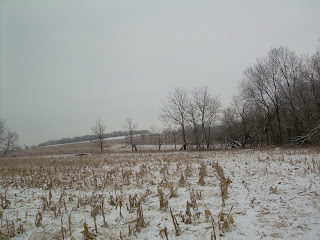 |
| I wish there were more of this during shotgun season! |
Let's start with a little weather 101 that every hunter needs to know. North American storm systems are local "low pressures" and when they push into a region, the power of the storm lifts air up into the sky. This creates clouds and can lead to rain, storms, snow and wind. When a storm moves in the barometric pressure falls. If you don't have a barometer - they're cheap, go get one. Otherwise, look for that big red "L" we show you on the weather maps. One's that move in from the west and southwest seem to have a bigger impact on deer movement before a storm.
In Iowa, low pressure systems can bring radical changes in weather ranging from tornadoes to blizzards. Inclimate weather threatens not only people's survival, but the wildlife too. While some animals are more sensitive to changing weather systems, most wildlife changes their patterns when a storm is coming. Birds hit the feeders harder. Squirrels scavenge furiously for nuts. And heavy horned bucks get out of bed to feed in the daylight.
A falling barometer puts deer on the hoof! One of my best hunting memories comes from a few years ago as I sat over a cut cornfield on the day before 1st Season. The clouds had been steadily thickening, the winds picked up from the east and the temperature was falling. Several inches of snow were in the forecast and the first flakes were sticking to my bow and turning the ground white. The first deer I saw was nearly an hour earlier than every other day I hunted that week. And a field that I'd normally see 10 deer on, suddenly was teaming with nearly 50.
Sometimes, I don't know who's a better forecaster: me or the herd of deer! It ended up snowing much more than expected as temps crashed colder than expected. It seems the animals instinctively know when the weather is changing and the ones who prepare are the ones who survive the storm.
Food sources and travel corridors to food sources are key ambush spots for a successful hunt before a storm. Once the storms hit, deer often hunker down until the worst is over. Stalking through a bedding area or setting up on a funnel or pinch point near a bedding area is key here. Deer sightings diminish rapidly when heavy precipitation hits, but they'll often move around if there are any breaks in the weather.
If there's one good thing about rain on Saturday - deer drives can be quite effective in seeing deer when the weather's foul.
Good luck and hunt safely on the final weekend of shotgun season 2012!
.JPG)
No comments:
Post a Comment